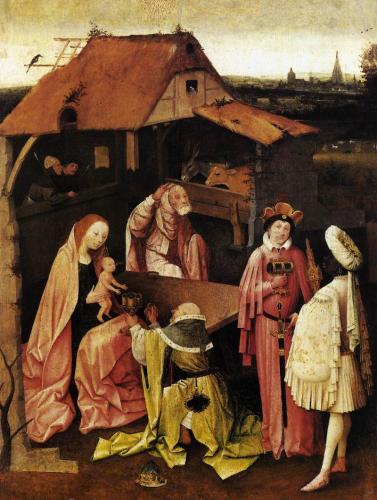 The Epiphany of our Lord -- Epiphany for short -- is the liturgical festival observed on January 6. The oldest Christmas festival, and originally the most important, It is still the climax of the Christmas season in the Eastern Orthodox tradition, where it is celebrated as Theophany. Epiphany as a season of the Lutheran liturgical calendar lasts until the beginning of Lent and encompasses four to nine Sundays, depending on the date of Easter.
The festival has not gone unnoticed by the media, which is nice. Much of the coverage is of the local color variety -- with brief articles and photos of Epiphany celebrations. The Times Herald-Record (N.Y.) looks at a Lutheran church's Christmas pageant -- held on Epiphany (observed in some churches last Sunday) as opposed to late in Advent.
The Epiphany of our Lord -- Epiphany for short -- is the liturgical festival observed on January 6. The oldest Christmas festival, and originally the most important, It is still the climax of the Christmas season in the Eastern Orthodox tradition, where it is celebrated as Theophany. Epiphany as a season of the Lutheran liturgical calendar lasts until the beginning of Lent and encompasses four to nine Sundays, depending on the date of Easter.
The festival has not gone unnoticed by the media, which is nice. Much of the coverage is of the local color variety -- with brief articles and photos of Epiphany celebrations. The Times Herald-Record (N.Y.) looks at a Lutheran church's Christmas pageant -- held on Epiphany (observed in some churches last Sunday) as opposed to late in Advent.
For those confused about when the 12th night of Christmas falls, this Telegraph story was no help, but it was fun.
Epiphany is celebrated with particular fervor in many Spanish-speaking countries. The BBC's brief look at Madrid's annual parade made me wish I was there. The Los Angeles Times reported on a 1,600-meter-long Rosca de Reyes baked by local bakers.
This Democrat and Chronicle (N.Y.) article caught my eye:
At the Church of the Assumption, part of the Roman Catholic Diocese of Rochester, packets containing a piece of chalk and a prayer were handed out during the service. Families took these packets home to write "20 CMB 09" above their front door with the chalk.
The numbers indicate the current year and "CMB" stands for the "Christus Mansionem Benedicat," which -- translated from Latin -- means "May God bless this house."
How bad does your Latin have to be to translate Christus as "God"?
The coverage of Epiphany celebrations in Tarpon Springs, Florida, is truly remarkable. Apparently the Greek Orthodox churches there have huge celebrations that bring in visitors far and wide. Rita Farlow, St. Petersburg Times reporter, has the beat covered, with several stories on the festivities. Here's a portion of one story:
Between 8,000 and 10,000 people are expected for the city's 103rd Epiphany celebration today, which begins with services at St. Nicholas Greek Orthodox Cathedral and ends with an eight-hour Glendi.
In between, 65 young men will dive to retrieve this year's Epiphany cross. The teen who finds the cross will receive a special blessing that is supposed to bring him a year of prosperity.
The reporter profiled a young woman who will release a dove as part of the festivities. A Suncoast News story looked back on the year had by the winner of last year's dive.
No matter how big or small the stories on Epiphany and Theophany were, they all handled the theological significance pretty well. Some media outlets used the occasion to get into deeper religious themes. The Ft. Wayne Journal Gazette ran a piece by an Orthodox priest. Beliefnet's Patton Dodd had an epiphany while teaching an Epiphany Sunday School lesson. The Rev. Peg Chamberlin's regular column in the Star-Tribune dealt with the topic. And the Santa Barbara Independent had an interesting piece on the similarities between Epiphany and Theopany:
One interesting aspect of these two parallel holidays is that they're much more similar, theologically speaking, than they would appear. To a secular observer, a visit from three Magi and a dip in the river Jordan are entirely different activities; their connection appears obscure. To a Christian scholar, however, they're both manifestations of Christ as the son of God.
She goes on to describe particular aspects of how the holy days are celebrated. So all in all, not a bad treatment of this major festival. Please let us know if you saw any particularly good or bad coverage of the day and season.
